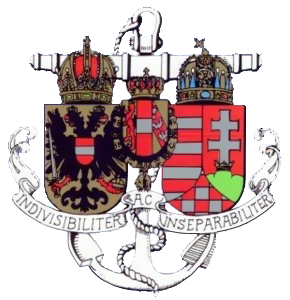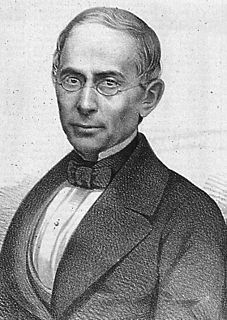
Juan Eugenio Hartzenbusch was a Spanish dramatist. He was the Director of the National Library of Spain until he retired in 1875.
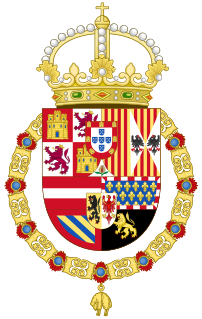
John of Austria was an illegitimate son of Holy Roman Emperor Charles V. He became a military leader in the service of his half-brother, King Philip II of Spain, and is best known for his role as the admiral of the Holy Alliance fleet at the Battle of Lepanto.

Francis IV Joseph Charles Ambrose Stanislaus was Duke of Modena, Reggio, and Mirandola, Duke of Massa and Prince of Carrara, Archduke of Austria-Este, Royal Prince of Hungary and Bohemia, Knight of the Order of the Golden Fleece.

The Battle of Lissa took place on 20 July 1866 in the Adriatic Sea near the Dalmatian island of Lissa and was a decisive victory for an outnumbered Austrian Empire force over a numerically superior Italian force. It was the first major sea battle between ironclads and one of the last to involve deliberate ramming.
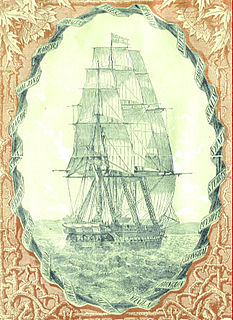
SMS Novara was a sail frigate of the Austro-Hungarian Navy most noted for sailing the globe for the Novara Expedition of 1857–1859 and, later for carrying Archduke Maximilian and wife Carlota to Veracruz in May 1864 to become Emperor and Empress of Mexico.

The central battery ship, also known as a centre battery ship in the United Kingdom and as a casemate ship in European continental navies, was a development of the (high-freeboard) broadside ironclad of the 1860s, given a substantial boost due to the inspiration gained from the Battle of Hampton Roads, the very first battle between ironclads fought in 1862 during the American Civil War. One of the participants was the Confederate casemate ironclad CSS Virginia, essentially a central battery ship herself, albeit a low-freeboard one. The central battery ships had their main guns concentrated in the middle of the ship in an armoured citadel. The concentration of armament amidships meant the ship could be shorter and handier than a broadside type like previous warships. In this manner the design could maximize the thickness of armour in a limited area while still carrying a significant broadside. These ships meant the end of the armoured frigates with their full-length gun decks.

SMS Leopard was a torpedo cruiser (Torpedoschiff) of the Austro-Hungarian Navy. She and her sister ship, SMS Panther, were part of a program to build up Austria-Hungary's fleet of torpedo craft in the 1880s. Both ships, the only members of the Panther class, were built in Britain at the Armstrong shipyard in Elswick. Leopard was laid down in January 1885, launched in September 1885, and completed in March 1886. She was armed with a battery of two 12 cm (4.7 in) guns and ten 47 mm (1.9 in) guns, along with four 356 mm (14.0 in) torpedo tubes.
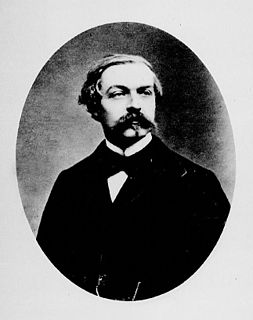
Antoine-Auguste Laugel was a French historian and engineer born in Strasbourg.
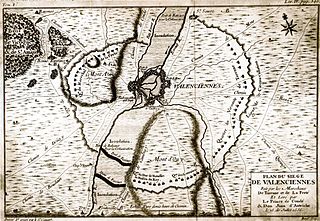
The Battle of Valenciennes was fought between the Spanish troops commanded by Don Juan José de Austria against the French troops under Marshal Henri de la Tour d'Auvergne, Vicomte de Turenne, in the outskirts of the town in the Spanish Netherlands, during the Franco-Spanish War. It was the worst of only a few defeats that the French Marshal Vicomte de Turenne suffered in his long career campaigning and is regarded as Spain's last great victory of the 17th century.
The Austro-Hungarian Navy operated a pair of ironclad warships named SMS Kaiser Max:

SMS Kaiser Max was an ironclad warship built for the Austro-Hungarian Navy in the 1870s, the lead ship of the Kaiser Max class. The ship was purportedly the same vessel that had been laid down in 1861, and had simply been reconstructed. This was a fiction, however; the head of the Austro-Hungarian Navy could not secure funding for new ships, but reconstruction projects were uncontroversial, so he "rebuilt" the three earlier Kaiser Max-class ironclads. Only the engines and parts of the armor plate were reused in the new Kaiser Max, which was laid down in February 1874, launched in December 1875, and commissioned in October 1876. The ship's career was fairly limited, in part due to slender naval budgets that prevented much active use. She made foreign visits and took part in limited training exercises in the 1880s and 1890s. Long since obsolete, Kaiser Max was removed from service in 1904 and converted into a barracks ship. After World War I, the ship was transferred to the Royal Yugoslav Navy as a war prize and renamed Tivat. Her fate thereafter is uncertain, either being sold for scrap in 1924 or retained through 1941.

The Kaiser Max class of broadside ironclads was a group of three vessels built for the Austro-Hungarian Navy in the 1860s. The class consisted of Kaiser Max, the lead ship, Prinz Eugen, and Juan de Austria. They were an improved version of the preceding Drache class, being larger, carrying a larger gun battery, and having more powerful engines. The three ships were all laid down in 1861, launched in 1862, and completed in 1863.
Three ships of the Austrian and later Austro-Hungarian Navy have been named SMS Prinz Eugen in honor of Prince Eugene of Savoy

SMS Basilisk was a Camäleon-class gunboat of the Prussian Navy that was launched in 1862. A small vessel, armed with only three light guns, Basilisk served during all three wars of German unification in the 1860s and early 1870s. The ship was present during the Battle of Heligoland in May 1864 during the Second Schleswig War, but was too slow to engage the Danish squadron. During the Austro-Prussian War of 1866 and the Franco-Prussian War of 1870–1871, Basilisk was stationed in the North Sea to help defend the coast, but she did not see action during either conflict. Between 1873 and 1875, she was employed experimentally as the first torpedo-armed warship of the German fleet. Basilisk was decommissioned in 1875, renamed "Mine Barge No. 1", and converted into a naval mine storage hulk. The details of her fate are unrecorded, but she was still in service in that capacity at least as late as 1900. Sometime thereafter, she was broken up.
This page is based on this
Wikipedia article Text is available under the
CC BY-SA 4.0 license; additional terms may apply.
Images, videos and audio are available under their respective licenses.
